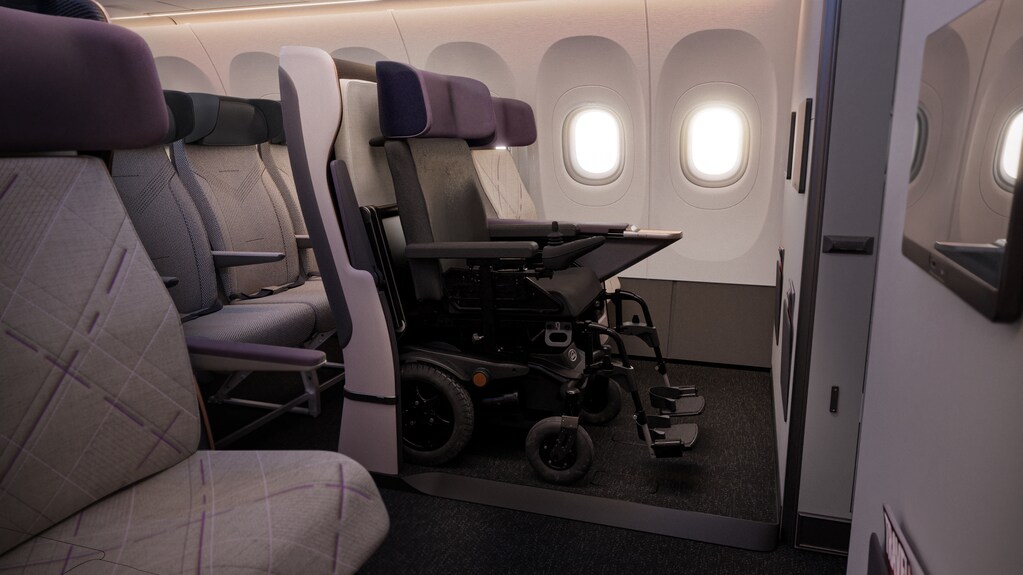The concept is still in early stages but would be a major advancement for passengers with disabilities.
John Morris had to see it for himself.
An accessible travel expert who uses a power wheelchair, Morris flew to Hamburg to check out a prototype of a new airline seat being unveiled by a subsidiary of Delta Air Lines on Tuesday that could dramatically — although not immediately — improve the flying experience for wheelchair users.
In an email from Germany, Morris called the seat a “tremendous first step in the race to accommodate disabled passengers’ personal wheelchairs in the aircraft cabin.” Travelers who use motorized wheelchairs have been asking for such a solution for years as complaints have mounted about damage to chairs that have to be stowed with luggage.
Last year, U.S. airlines mishandled 11,389 wheelchairs and scooters, or 1.54 per 100 that were loaded onto planes.
Delta Flight Products, a subsidiary of Delta Air Lines, showed off the prototype at the Aircraft Interiors Expo in Hamburg. The concept is the result of years of work, first among a group called Air 4 All that includes design studio PriestmanGoode, advocacy organization Flying Disabled, wheelchair manufacturer Sunrise Medical and SWS Certification, which works to get approvals for airplane interior products.
The consortium has been working with Delta Flight Products for more than a year but only announced the partnership in recent days.
“With their contribution we have reached a position where we have a fully working prototype that DFP can showcase to all airlines,” Daniel MacInnes, director of PriestmanGoode, said in an emailed response to questions. “Having something tangible for users to test and to demonstrate brings it much closer to flying, but no announcements have been made on the first airline partner.”
The system allows airlines to keep the designs of their cabins and lets a standard seat fold up to accommodate a wheelchair restraint. If no wheelchair user is on board, it can be used like any other seat. The prototype has been developed for the front row of a narrow-body plane and could fit two power wheelchairs, one on each side of the aisle, according to PriestmanGoode. Travelers would have access to the seat’s headrest, center console tray tables and cocktail table.
The system would not make it possible for travelers to use their own chairs to get into lavatories; a manual transfer to the restroom would be necessary using a smaller wheelchair. Planes with more than one aisle need to have an accessible lavatory, but under an agreement reached in 2016, single-aisle planes will not be required to offer the same accessibility for years still.
MacInnes said the goal is to be able to fit as many kinds of power wheelchairs as possible.
“The reason for the focus on powered wheelchairs is that those users face the biggest barriers and transfer to a standard seat is not an option for them as their wheelchair is an extension of their body and essential for the entire journey,” he said in the email.
In a statement, Delta called the system “a first-of-its-kind airplane seat” but cautioned that the process was still far from appearing in a cabin.
“This product remains in its early development stages, with approximately 18 months of work and reviews ahead, but Delta will keep a keen eye on the progress of this concept being driven by our subsidiary — as we are always looking for ways to improve the travel experience for all customers,” the statement said.
MacInnes said design decisions would be finalized based on feedback during the expo in Hamburg, then the application for regulatory certification would begin. The seat would then need to be tested, including in flight trials.
The seat would be available to Delta as well as other airlines, but it’s not clear how long it could take beyond those 18 months before such an option could be available for travelers.
The debut follows a push from U.S. officials to make air travel more accessible for wheelchair users. Last month, a group of bipartisan senators introduced a bill that would require the Transportation Department to report on the type of damage that occurs to wheelchairs and mobility aids.
“No other form of transportation — trains, buses, boats — forces you to give up your mobility device when you board. The same ought to be true of airlines,” Transportation Secretary Pete Buttigieg said last summer. “So, in the months and years ahead, we plan to work toward a new rule that will allow passengers to stay in their personal wheelchairs when they fly. We know this won’t happen overnight, but it is a goal that we have to work to fulfill.”
Morris, founder of WheelchairTravel.org, said in his email that the seat’s integrated securement system “shows promise” in locking in powered and manual wheelchairs.
“No wheelchair securement concept has made it this far in the design and development process, and I believe that it offers a solution that could one day make air travel significantly more accessible to millions of wheelchair users,” he wrote.
He cautioned that more work was needed to make sure some complex rehab power wheelchairs like his could be accommodated, but said that the team that demonstrated the system to him seemed confident that the majority of wheelchairs could fit in future versions.
“I’m optimistic about an accessible air travel future!” Morris wrote.
Source: Washington Post

